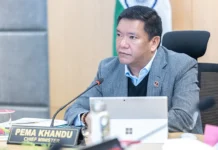[ Dr Likha Kiran ]
ITANAGAR, 25 Jul: Seventeen sustainable development goals (SDG), with largely 169 targets and 300 sustainable development indicators, is an agenda for transforming the world on a sustainable basis adopted in the United Nations Assembly that came into effect from 1 January, 2016.
At the core of this global agenda for 2030 is the principle of universality: ‘Leave no one behind’. India is strongly committed to this agenda with its national development goals, ‘Sab ka saath, sab ka vikas’, or ‘Development with all, and for all’ policy initiatives for inclusive development.
NITI Aayog – National Institution for Transforming India – a think tank of the government of India, by taking the lead role has a twin mandate to oversee the adoption and monitoring of the SDGs in the country. ‘Whole of government’, converging all the resources of ministries, complemented with ‘whole of society’; approach with institutions, organisations, CSOs, youths, private sector, community and all stakeholders collaborating, will bring transformations changes and achieve the SDGs in PRIs.
In the state, the planning & investment department is spearheading the execution of the SDGs. To achieve the SDGs, execution is required to take place at grassroots level to achieve the goals in realistic terms. The MoPR in 2021 constituted an expert committee for a systematic approach to localisation of SDGs. The expert committee identified nine SDG-linked themes for focused interventions through panchayats.
The nine themes are: Poverty-free and enhanced livelihoods village; healthy village; child-friendly village; water sufficient village; clean and green village; self-sufficient infrastructure in the village; socially secured village; village with good governance; and engendered development in the village.
SIRD&PR, Itanagar, entrusted with the responsibility of capacity building training to PRIs, started the orientation on these themes in October 2022, involving all the departments concerned, for localisation of SDGs. From this year (2023-’24), the gram panchayat development plan is required to be prepared, focusing on one of these themes every year. The gram sabhas, on the basis of gap identified in Mission Antyodaya report and funding pattern of the 15th FC and programmes implemented at gram panchayat by various departments has to be analysed to finalise the theme and take resolution in sabha.
SIRD&PR, Itanagar conducted a five-day training of trainers in July, 2023 to create a panel of resource persons pooled from college, line departments, NGOs and key persons from Longding, Changlang, Tirap and Anjaw districts for further rolling out of the training at the state, district and block levels on LSDGs.
The steps that are involved in execution of localisation of SDGs, local goals, target and role of panchayats, departments, and community organisations on nine themes were discussed during the training. Three success stories were presented in the training.
- Tana Agyang Pulyang viewpoint, a sustainable model of convergence created just at the cost of about Rs 21 lakhs in two years period (2021-2023) in Ziro, Lower Subansiri district. The project was conceived and executed under the leadership of SIRD&PR Director Habung Lampung, with active participation of the community and MGNREGA job card holders.
- Ozakho gram panchayat, the recipient of the Chief Minister’s Cleanest Village Award 2022-’23. This village became a clean, green and water-sufficient village in a span of less than two years. GPC Wangjem Wangsa, after coming back from an exposure visit to study the Sikkim panchayat, which was organised by SIRD&PR, convinced the village council and villagers to execute best learning and the Jal Jivan Jeevan Mission in Ozakho village, consisting of 150 households successfully. Ozakho is raising about one lakh revenue per annum from water user charges, renting out the furniture and a poultry farm as own source revenue (OSR). Hunting and drugs are banned in this gram panchayat.
Efforts in making plastic-free Anini were presented by Anmol Singh, 2022 batch of APCS. Anini joined the Pakke Declaration on the occasion of the World Environment Day (5 June, 2023). A qualitative survey has been conducted by involving the students from the government higher secondary school and the Mahatma Gandhi National Fellow of Dibang Valley in an offline manner. Analysis reports of 476 respondents further determine to reduce the current status of single-use plastic bags and gradually replace them with cotton reusable bags in the district.
The Dibang Valley district administration is all set to distribute the bags at a very affordable price with active participation of panchayats, the Indian Army, SHGs and communities. Reuse, recycle and manufacturing arrangement of bags are intact in the project plan.
Adding to this localisation initiative, the gram sabha of Arzoo gram panchayat passed the resolution in the form of the Arzoo Declaration, which indicates that the district has started the localisation of SDGs. Most of the targets of nine themes are reflected in this declaration. This needs to be replicated in other gram panchayats. Ozakho also passed this kind of resolution on of 2 October, 2022 in a gram sabha and surrendered the airguns to the district administration.
Anini CO Anmol Singh, who attended the five-day training with full sincerity at the SIRD&PR, Itanagar in 2022, shared the vision and activities of gram panchayats in the district. It can be observed that, in Dibang Valley, the process of localisation has taken off and is heading towards the goals. It is expected that the rest of the districts would follow suit – the main motto of this write-up. (Dr Likha Kiran is a senior faculty in the SIRD&PR, Arunachal Pradesh)


